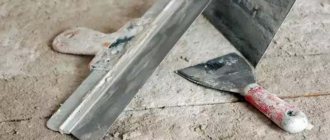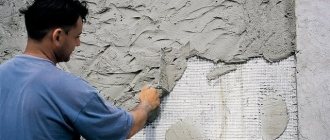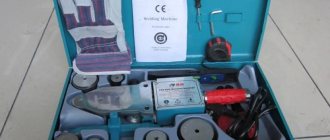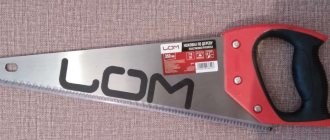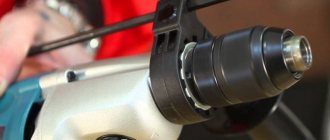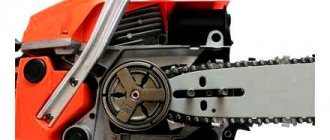Hands from the right place | 05/14/2016
The most common tools when carrying out construction, painting and other types of work are spatulas. The largest group among them are spatulas for puttying walls. They often differ in standard sizes and shapes necessary for specific work.
Which spatula is best for puttying walls?
The main types of spatulas include:
- A paint spatula is best for finishing walls. Using a painting spatula, perform the following types of work:
- leveling out unevenness after preliminary application of putty;
- sealing dents and cracks;
- puttying of structures of complex shape;
- masking seams between sheets of drywall.
The spatula has a trapezoidal shape and is most often equipped with a plastic handle. Painting spatulas have a number of distinctive features from all other types of putty spatulas:
- small plate thickness;
- flexible and elastic blade;
- the minimum tool width is 2 cm;
- are made of stainless steel.
- Facade spatula - as a rule, it is used for exterior work; it is also used for interior decoration as an auxiliary tool. The working surface, like that of a painting spatula, is made in the shape of a trapezoid. The spatula for facades has a wide blade (from 30 to 60 cm), which is made from carbon steel, which has increased strength characteristics and therefore practically cannot be bent. The handle can be made of wood or plastic. The special shape of the spatula helps to apply construction mixtures over fairly large areas.
- A corner spatula is a specialized type of putty tool that allows you to process internal and external corners. The shape of the spatula is a right angle.
Selection criteria
The main property is sufficient blade rigidity. If this criterion is not met, the work will be of poor quality. Professional devices are equipped with a comfortable rubberized handle. To organize any work, there are three types - narrow, wide and medium. Specialized models are designed to handle corners and apply specific surface conditions.
Variety of models
Other types of spatulas
In addition to the main types of staples, on the construction market of tools for puttying walls, you can also find other forms of similar tools. Among them are:
- spatula-scraper - used exclusively when it is necessary to remove excess amounts of material from the surfaces being treated. The width of such a spatula can vary between 50-70 mm, and the blade is highly flexible;
- rubber spatula - ideal for working with sealants, processing tile joints and puttying small surfaces. They are usually produced with a plate width of 40-80 mm;
- figured spatula - used to give the treated surfaces a certain texture, for example, when applying liquid wallpaper and decorative plaster. Often, curly spatulas are made of plastic;
- notched trowel – necessary for applying construction adhesive to the surface. Depending on the type of glue, the type of spatula is selected individually. When using tile adhesive, you should use a spatula with small teeth; for gypsum adhesive, use a tool equipped with large teeth; and for liquid glue, a spatula with small, triangular-shaped teeth is ideal. The width of the working plate can be 200-300 mm. Experts recommend working with a notched trowel only on flat surfaces.
Correct Application
Regardless of whether wallpaper, paint or decorative plaster is applied to the walls, at the first stage the surfaces should be leveled and all cracks should be removed. After this, the walls are plastered and degreased.
The next stage is priming the surfaces . When the walls are dry, you can apply the starting putty. During such work, it is necessary to use a spatula correctly. The primer solution is prepared from a dry mixture and water. You should get a homogeneous consistency, for which it is recommended to use a construction mixer. The prepared solution is taken from the container with a small spatula and applied to a wide one. The mixture is applied to the surface at an angle of 45 degrees. As soon as the excess solution on the large instrument begins to dry out, it is removed with a narrow blade. Otherwise, scratches will remain on the walls.
After the putty has dried, the surfaces are primed again and covered with paint, wallpaper or plaster. If decorative plaster is to be applied, then curly tools are used to obtain the desired effect.
Standard sizes of spatulas for puttying walls
Any typical spatula for puttying walls consists of a plate and a handle, and the quality of wall leveling during operation directly depends on the smooth edge of such a tool. The plate can be made of different types of material, mainly: metal, rubber, plastic.
Among the variety of models of spatulas for puttying walls, the following are distinguished:
- non-professional types - specialists usually call them disposable. In appearance, they have a thin plate (usually less than 0.5 mm) and a black plastic handle;
- professional - equipped with a 1 mm plate that does not bend under the slightest load.
The main criterion for the quality of a spatula is its rigidity, which does not repeat, but corrects unevenness.
Regarding dimensional characteristics, the following are considered standard:
- length – depending on the type of work, the length of the spatula is selected individually. A tool that is too long, just like a short one, will not be a good choice. When plastering walls, a long blade can bend and thereby negatively affect the quality of wall finishing;
- width – the most optimal size of a painting staple is considered to be 100-150 mm in combination with a facade staple with a canvas width of 300-450 mm. For puttying, spatulas with a width of 2 to 80 cm are most often used. Narrow spatulas up to 8 cm are used when processing hard-to-reach places. It is impossible to completely level the surface with a narrow spatula, as it follows the curves of the walls. A tool with a width of 10-25 cm is often called a typesetting tool, as it helps to transfer the putty mixture to a working spatula. Spatulas up to 30 cm allow you to level small surfaces. The largest spatulas with a width of more than 30 cm help to correct noticeably curved walls, large and gross defects. Using spatulas 60 cm wide, the starting putty of the walls is carried out with the obligatory application of a rough thick layer.
If you are not a professional finisher, you should not buy a spatula wider than 400 mm (it will be quite difficult to work with such a tool without certain skills and knowledge).
Trusted manufacturers
German is known to Russian consumers as a seller of repair products such as rollers, brushes, glue guns, paint containers and spatulas. This entire tool has proven itself to be unpretentious and reliable among professional builders. Biber spatulas are produced for different types of work and are made of various materials - stainless steel, plastic and polyvinyl chloride, with wooden and plastic handles.
The FIT-Tool company is an official dealer of the Canadian company, producing electric and hand tools for household and professional use. It has a large network of branches throughout Russia. One of the niches in hand tools for every day is occupied by painting and plastering and finishing models. The advantage of FIT spatulas is their affordable price, quality, ergonomics and variety of models and types.
Today the Russian market is developing dynamically. It specializes in the production and sale of hand-held construction tools. The company is constantly increasing the output of finished products and assortment, and regularly modernizes production. High-quality raw materials are used in the manufacture of spatulas. The combination of price and quality makes them affordable for consumers and makes them in demand for professionals.
Related article: Supporting floor slabs on SNIP walls
A participant in the global market for quality goods is the well-known Russian one. The company regularly increases its range and improves its finished products. It has its own testing laboratory where, before reaching consumers' shelves, products undergo multiple tests. Spatulas from this company are presented in two-component and plastic variations. A quality service created specifically for this purpose is responsible for their quality.
This is not the entire list of manufacturers of quality spatulas in the middle and budget price categories.
How to clean the tool
There are many videos and articles on this topic on the Internet. But these two options are considered to be the most common.
For effective cleaning, you just need to delicately treat the contaminated surface with iron filings.
It is rational to use a wet rag to brush away falling dust particles. After a few minutes of manipulation, the instrument will look like new.
In this way, even old, long-hardened putty can be easily cleaned. Some people recommend using sandpaper, but it can damage the delicate surface of the spatula. This method can only be used by professionals who know how to control the intensity of friction.
Summarize
We talked about how to choose a spatula for a specific type of work. But we didn’t talk about how many tools you might need during the repair. Let's do the math.
Even when performing the simplest finishing work, for example, when wallpapering, you will need at least two spatulas. One is metal with a narrow working part - for peeling old wallpaper from walls, as well as for filling small defects with putty, the second is plastic for smoothing wallpaper when gluing. What can we say about more complex work, such as laying tiles. After all, the wall must first be leveled with plaster - you will need a spatula with a wide working part, when applying tile adhesive you need a tool with a serrated blade, and when molding seams - a rubber spatula. Remember that for painstaking work and work in hard-to-reach places you need to have several spatulas, or better yet, a set. This will allow you to choose the most suitable device based on the complexity of the task.
If you have already decided which spatulas you will need for your work, you can choose the tools from those presented on our website. The catalog contains about 100 spatulas from such well-known manufacturers: Kraftool, MATRIX, HARRIS, STAYER and others. To place an order, fill out the electronic form on the website or call the manager.
Source
Let's pay attention to the handle
If the working part of the spatula determines how the construction mixture will be applied and leveled, and, consequently, the efficiency of the work, then ease of use depends entirely on the handle. After all, if holding the tool is uncomfortable or it slips out of the palm, then the hand will quickly get tired, and this will also affect the quality of the application. To make it easy to work with a spatula, the handle must be suitable. This largely depends on the material.
Previously, spatulas, like many other hand tools, had wooden handles . Some manufacturers still adhere to this tradition, since the wood is light and at the same time durable. But it happens that when processed poorly, the material begins to dry out, burrs and other defects appear. Therefore, if you prefer wood, pay attention to the fact that it is varnished or painted.
Today, the most popular tools among both amateurs and professional finishers are tools with two-component handles . The base is made of durable plastic, and there are rubber or silicone inserts in the places where the palms and fingers should be located. This handle is ergonomic, it is comfortable to hold, and your hand does not slip. In addition, plastic is not subject to rotting, corrosion and other defects during operation.
It is worth noting that not all tool models have a handle. Rubber and so-called Japanese spatulas do not have it, but instead there is a small holder at the base of the working part. In this case, this is not a disadvantage, but is specifically provided for. After all, when carrying out painstaking work, a long handle will only be a hindrance - the closer the palm is to the working part, the better it feels the surface and the better it will be possible to apply the finishing material.
Choosing a tool for applying finishing putty
In order not to get completely confused in the presented options and to purchase a product that will perform the assigned tasks, we recommend that you pay attention to such characteristics. First of all, you should pay attention to the handle.
It should be comfortable, and it is better if there are no flaws or sharp protrusions on the surface of the metal. If they appear during the work process, this indicates that you are about to purchase a low-quality product.
Do not purchase items that are too long or narrow. They will be inconvenient to use during operation, while they are extremely difficult to operate.
To level the surface, it is more rational to purchase a product that is shaped like a trapezoid. Tools in the form of triangles or droplets are not so convenient.
Moreover, they performed poorly during operation. The blade of the working tool should be smooth, at the same time moderately flexible, and not deform with minimal pressure.
Ceramic brick is a material that has been successfully used in construction and renovation for a long time. Here are the pros and cons of this brick.
Putty can almost perfectly level the surface, as well as make it strong and durable. Here you will find out how long the putty takes to dry.
Crushed stone is mined by crushing rocks and metallurgical waste. By clicking on the link, you will become familiar with the characteristics of the flakiness of crushed stone.
If, while pressing on the blade, it begins to bend strongly during operation, the construction mixture will roll off such a spatula, and it will even be difficult to apply it to the wall, not to mention leveling it. Spatulas with excessive rigidity will undoubtedly become deformed during operation.
The correct spatula should be equipped with a blade that will spring slightly when pressed. To apply the finishing putty, you can use a tool whose blade is made of stainless steel.
This will make it easy to clean after work and will ensure there is no corrosion that will negatively affect the finish. A spatula with an iron blade and metal coating is considered a low-quality product and requires the utmost care to prevent the formation of rust.
It can negatively affect not only the material, but also the treated surface. Pay attention to the blade. There should be no sharpening points on it; it is rational to use such products for other types of work.
For more information about choosing a spatula, watch the video:
Content:
Have you planned a major renovation in your apartment? Or maybe you just want to repair the foundation of your country house? Then it is worth remembering that purchasing construction and finishing materials is not all that is needed before starting work. To make it easier to cope with the task and get an excellent result, you need to choose the right tool for applying the working solution. Today, customers are offered a huge number of spatulas of different shapes and sizes. But at first glance it is not always clear which of them is intended for what. After all, it’s one thing to putty joints and seal small defects in the walls, and another thing to level all the walls in a room with plaster. There are also jobs that cannot be handled with a regular spatula, for example, applying tile adhesive or decorative plaster. So that you do not waste a lot of time searching for the right tool specifically for your tasks, we will tell you about the parameters by which you should choose a spatula.
What is the working part made of?
The traditional material in the production of spatulas has always been stainless steel , as it is durable and does not corrode due to frequent interaction with mortars and water. Such a blade does not bend from the weight of the construction mixture and does not break when working even with a very thick mass. Spatulas with a stainless steel working part are used for plastering and puttying walls, applying tile adhesive, sealing cracks and recesses in walls, and they are also excellent for removing old wallpaper, paint and other finishing coatings. These tools are durable, store well and will survive more than one repair.
When performing finishing work, for example, applying decorative plaster or grouting the seams of facing tiles, you need a spatula with a flexible working part - rubber . This device allows you to perform painstaking work, applying putty to curved surface areas and corners. In addition, the rubber spatula is elastic, so it is gentle on the surface and will not leave scratches or other damage to finishing coatings. Imagine what will happen to a new tile if you run a metal spatula along its edges...
Also on the hand tool market there are spatulas that are entirely made of plastic . They are used either for final leveling of surfaces with not very thick putty, or as an auxiliary device when gluing wallpaper. This tool is very convenient for removing bubbles and excess glue from under the canvas without spoiling its appearance. Plastic spatulas are lightweight and do not corrode; their only drawback is that the working part may break if you try to work with viscous building mixtures. But when used as intended, they last a very long time.
Differences in blade width
By size, spatulas for puttying walls are divided into several types:
- wide spatula - blade width parameters vary between 15 - 40 cm. The tool is used to level the surface, eliminate curved areas, and evenly stretches the putty mixture;
- medium - the plane reaches 10 - 15 cm in length. The purpose of this type of spatula is pothole repair. With its help, they achieve smoothness of the wall;
- narrow spatula - the minimum spatula size is 2 cm, the maximum is 10 cm. With this tool, minor defective areas left after working with a medium spatula are filled. It will not be possible to level the surface, but it is very convenient to take the mortar mass from the container and transfer it to a large spatula.
When deciding which tool to choose for the job, take into account its type, purpose and existing skills.
Varieties
Spatulas are used to perform different types of work, so the choice of tool depends on its purpose. But it’s immediately worth noting that at different stages of repair you may need different spatulas.
Facade
This tool is used for plastering and puttying walls, followed by leveling the solutions and eliminating all defects. If the surface area is large and has already been prepared, then it is advisable to use the façade type, the working surface of which can vary from 150 to 800 mm.
The price of such a tool is quite high and this is due to the fact that only durable and high-strength materials are used for production. So the working surface is deformation-resistant metal alloys.
In this case, the blade is attached to the handle with an aluminum profile, which reduces the risk of tool breakage to a minimum. The handle of the spatula is rubberized and comfortable; the tool does not slip out of your hands when working.
Serrated
Such a tool is easily recognized by its serrated working surface, mounted in a wooden or rubber handle. The serrated type is used for applying adhesive to the surface of walls or floors, followed by cladding with tiles, ceramics and porcelain stoneware.
If the tile is large, then the teeth should be large; for small mosaics, you should choose a tool with fine teeth. The correct choice of tool is the key to high-quality adhesion of the tiles to the base and saving on the adhesive solution.
Corner
These spatulas differ from other types by their metal working blade, curved at a right angle, with a comfortable handle. A tool like this helps align corners or spaces between walls and ceilings.
Note! If the accuracy of the corners was violated when planning the room, difficulties may arise when using such a spatula.
Painter
For those who do not know which spatula to choose for finishing putty, experts advise purchasing a painting-type tool. In design, it resembles a façade trowel, differing only in the size of the working blade - they vary between 200-450 mm.
At the same time, their working canvas is thinner; the metal used for production is not of the highest quality, so the price for them is not as high as for façade ones. But such characteristics also cause disadvantages of the tool, which include an increased likelihood of failure and a reduced service life.
But if you need to apply a thin layer of facing material, that is, the final layer, then a paint spatula is ideal for such work.
Rubber
To manufacture this type of tool, dense, flexible and elastic rubber is used. The price will depend on the characteristics, size and manufacturer of the spatula.
The tool has a wide working surface with a wooden or rubber handle. It is used to work with finishing putty, to grout joints and putty seams, as well as to eliminate defects on the surface.
Rubber spatulas differ from other types in their high elasticity and wide range of applications.
